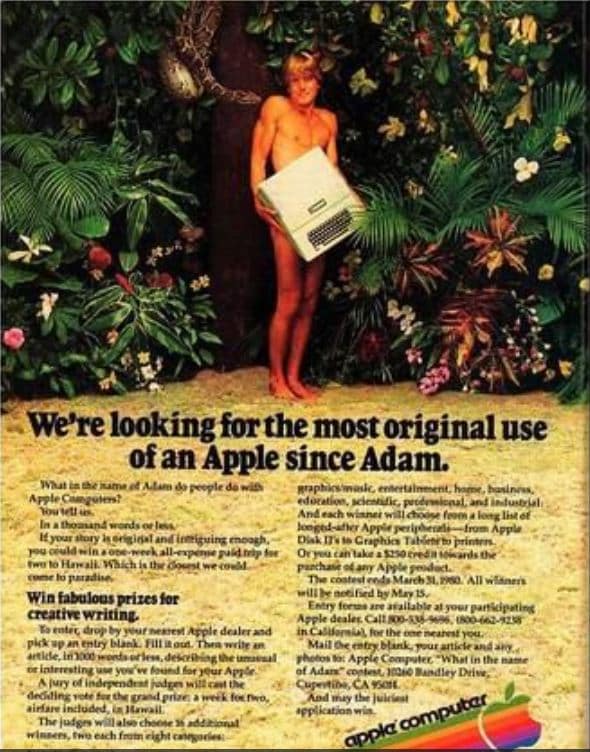Identify attitudes and motivations to find a common thread between your desired target customers using psychographics.
Introduction
It’s not easy picking a favorite
One of the most poignant examples of a brand that focused its positioning on a single, specific attitudinal consumer audience is Apple. Remember their launch advertising from the 1990s? Apple went straight after the ‘young’ and ‘artsy’ customer. They marketed their products heavily towards customers that demonstrate certain attitudinal behaviors. This advertisement is clearly targeting creative writers. Everything from the colorful rainbow to the then-risque picture of Adam speaks to a hip, creative, and artsy audience.
An apple magazine excerpt from the 1990s

Looking at the success of Apple today, one would argue this segmentation focus was one of the best decisions they made: it not only made one group completely “get” why Apple was right for them, but it also attracted a larger group of customers who may not be creative but aspired for something different and refreshing. That being said, back in 1989, making this choice would not have been easy, and what Apple probably grappled with is something we see many businesses ask: how do we pick a target customer audience without alienating other potential customer segments?
We know that in order to have a strong brand positioning, you need to identify a clear target customer, but often times we see businesses struggling on which segment to choose. They often feel that they have multiple segments that are mutually exclusive; going after one might detract another.
The key to avoiding this dilemma is to define aspirational target consumer groups based on attitudes and motivations, rather than demographics and behaviors. This is known as psychographics.
This doesn’t mean you should throw all of your hard work gathering demographic data out of the window or that you have to be as selective as Apple. It does mean, however, that you have to recognize the limitations of relying solely on demographic data.
I still remember the classic example of the pitfalls of demographic segmentation from my college marketing classes: how would you market to a consumer target of female, 35-44, divorced, has children, high school education? Interestingly enough, Princess Diana fit this description perfectly.
While it’s dangerous to make assumptions solely based on demographic or behavioral data, it’s also a missed opportunity to believe that vastly different demographic segments can’t share similarities. Let’s take a look at Nike.
Nike’s core customers were initially premiere athletes who performed at a professional level. When the company started to expand to a broader demographic, new subgroups emerged: middle-aged runners, young creatives who wore sneakers for style, fitness enthusiast mothers, etc. In spite of these demographic and behavioral differences, they all had one thing in common – they believed in pushing themselves to the max, overcoming hurdles to become better, and never settling for the status quo.
Nike’s brand positioning and marketing communication speak to a target customer who desires to push limits. Nike believed in sharing the experience of athleticism, the runner’s high, the lightness of being and this was something many people could relate to, regardless of age, gender or athletic abilities.
Defining your customer segments using psychographics gets to the why behind the who, the motivations behind your most valuable customer’s behavior. This pivot in how you define your customer can help you construct business strategies, marketing strategies & campaigns, messages and more that are relatable, predictive and effective. Without the fear of alienating one specific segment, you can find the common golden nugget they can all aspire to, and make your brand’s positioning meaningful and relevant to them.
Here’s how you can get started with finding your most valuable psychographic segment:
1. Purchase Funnel Analytics:
Identify customers who are buying your products today and understand the motivations behind their purchases. Are they price-conscious consumers who purchase solely on deal or promotion? Were they looking at another product and then impulsively reacted to a cross-sell offer? What product benefits were the consumers most attracted to? Understanding how and why they purchase could help find clues on common motivations across demographic segments.
A great example is Starbucks. Why do different people from various demographic and behavioral segments come over and over again to Starbucks? Is it the quality of the food? The attraction to overpriced coffee in Italian-sounding sizes? The embedded humor in anticipating what wrong-spelled name the barista will write for you today? In all seriousness, Starbucks understands that beyond the basic reasons why people purchase at their stores, a common theme is they all come for the experience of Starbucks. Thus they come for the comfort of drinking and eating and hanging out in a place outside of home or work. This psychographic insight not only influenced Starbucks’ marketing strategy but got embedded into the brand’s identity as a “3rd place” hangout destination.
2. Social Media Observations:
Understand how customers relate to your product or category on Facebook and Twitter, in blogs, or even through imagery on Instagram and Pinterest. Go beyond how they talk about your brand or your competitors. Look for how they engage with the product or category. This gives you clues on how your brand can resonate with them at a higher level. I recently worked with a client who makes products for mountain bikers. While the client originally thought only the most experienced bikers were thrill seekers, a look at a collage of images from Instagram from bikers with a variety of experiences and ability showed a common theme that everyone took risks to push themselves. This becomes an important psychographics insight that helps them define and speak to a broader target group.
3. Consumer Research:
While this takes time and investment, consumer research can unveil tons of insights. So you can uncover the golden nugget that ties different groups together. Consumer research can be conducted through online surveys with either current customers or a broader group of potential customers who are aware of your brand but may or may not have purchased in the past (recommended).
To go deeper, focus groups (online or physical) and ethnographies (interviewing customers at home or work – wherever they engage with your product on a regular basis) can supplement what you learn in surveys and provide a deeper perspective on the connections between behaviors and attitudes. This can help with everything from marketing strategy & execution to product development and innovation. When fashion brand Vera Bradley wanted to appeal to a younger Millennial demographic without alienating its core consumer base, it leveraged online focus groups to garner insights that represented a common thread. The result: a new product idea for bags with built-in phone chargers.
Conclusion
Once you have found the common thread between your most desirable customer segments using psychographics, you can develop a singular, powerful marketing creative idea that everyone in this segment can relate to. This still allows for personalizing marketing tactics to reach each important demographic customer segment.
For example, let’s refer back to Nike’s “Just Do It” campaign. Although the message is always the same, Nike uses different marketing tactics to speak to several sub-audiences. They change where they place the ads, who they feature in the ads, and what kind of promotion or incentives they offer.
Brand positioning is all about making tough choices, but choosing your target customer doesn’t have to be. Psychographics-based customer segmentation allows you the flexibility to reach a broader audience with your brand’s message in a relevant and meaningful way.




